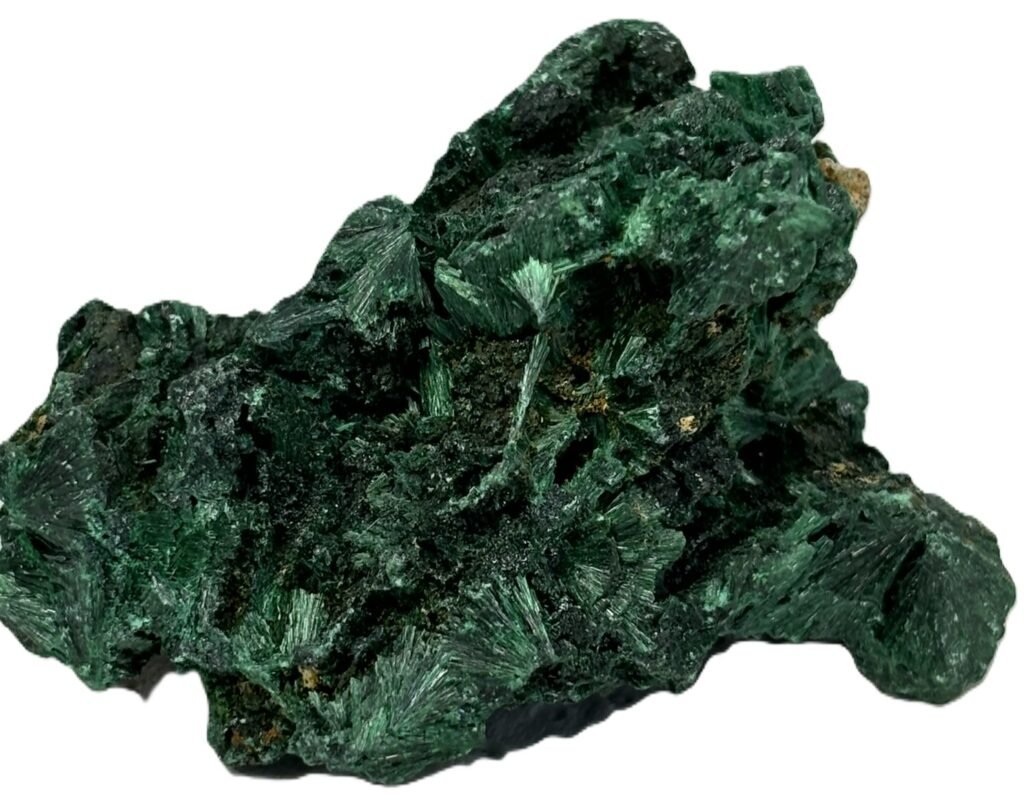
Velvet Malachite is a rare and unusal form of Malachite. The term malachite derives from the Ancient Greek malache, meaning “mallow,” a reference to its leaf-green hue. The word “velvet” describes its fibrous, matte texture—soft in appearance with a lustrous depth reminiscent of velvet fabric. In various markets, traders also refer to it as fibrous malachite, silky malachite, or moss malachite, likening its look to lichen or mossy tufts.
Composition, Physical Characteristics, and Varieties
Velvet Malachite belongs to the malachite family, a copper carbonate hydroxide mineral with the formula Cu₂CO₃(OH)₂. Its vibrant green arises from its high copper content.
This variety displays:
- Fibrous texture resembling fine threads or tufts
- Radial or needle-like crystal formations
- Matte-to-silky lustre, rather than the glassy polish of standard malachite
- Colour variations from deep pine to lighter grassy greens
Closely related varieties include botryoidal malachite, which forms grape-like clusters, and stalactitic malachite, often seen in banded or polished states. Most Velvet Malachite remains uncut and natural due to its delicate construction.
Geographical Sources
Velvet Malachite grows in the oxidised zones of copper deposits. Major regions include:
- Democratic Republic of Congo, famous for large, deeply fibrous pieces
- Namibia, offering high-quality specimens, sometimes fused with chrysocolla
- Russia’s Urals, once a prime source for architectural stone
- Australia, Arizona (USA), and Mexico, where smaller or composite specimens emerge
Congolese Velvet Malachite dominates the market today due to continued mining activity and quality.
Archaeological and Historical Significance
Cultures across time have prized malachite:
- Ancient Egyptians crushed it into cosmetics and carved it into amulets
- Greeks and Romans fashioned it into decorative and protective items
- Imperial Russia utilised vast Uralian reserves in palatial architecture, like the famous Malachite Room
While polished varieties featured in ancient décor, collectors and healers now increasingly seek raw Velvet Malachite for its organic texture and subtle presence.
Interesting Facts
- Velvet Malachite’s copper content imparts natural antimicrobial properties
- Some specimens display chatoyancy under specific lighting
- The stone remains fragile—exposure to moisture and direct sunlight should be avoided
- Its fibrous growth sometimes forms atop other copper minerals, creating multicoloured “mineral mosaics”
Folklore, Superstitions & Legends
Folklore ties malachite to transformation and protection.
- Slavic traditions dubbed it the Stone of the Forest Mother, a talisman for crossing spiritual thresholds
- Ancient guardians placed it in children’s beds to ward off evil
- Medieval folklore warned that malachite might fracture when danger approached
- Dreams featuring malachite symbolised release, healing, or a reckoning with buried emotion
Velvet Malachite, with its moss-like aura, plays a role in earth-centred rituals connecting to plant spirits, nature deities, and elemental energies.
Mystical Healing Properties
Healers turn to Velvet Malachite for:
- Emotional release, helping unearth deep-rooted patterns
- Protection, offering energetic shielding from manipulation
- Transformation, guiding spiritual evolution and rebirth
- Aura cleansing, drawing away residual energetic weight
Use it during deep meditation, ancestral work, or shadow practices to unravel internal tangles and restore clarity.
Zodiac and Astrological Alignment
This stone resonates most strongly with:
- Scorpio, for releasing emotional intensity and uncovering truth
- Capricorn, encouraging emotional agility and restoration
- Taurus, supporting groundedness and harmony through its Earth connection
Astrologers associate Velvet Malachite with Pluto (transformation), Venus (compassion), and Earth-aligned energies.
Chakra Work
Velvet Malachite aligns closely with the heart chakra, nurturing emotional honesty and loving release. It also connects to the:
- Solar plexus chakra, fostering courage and personal growth
- Root chakra, anchoring the spirit during spiritual or emotional shifts
Its fibrous build complements gentle energy work, especially during periods of transition or renewal.
Birthstone and Anniversary Usage
Although not a traditional birthstone, malachite frequently serves as an alternative for May, reflecting spring’s verdant rebirth. It also symbolises the 13th wedding anniversary, representing transformation, endurance, and deepening connection.
Crystal Pairings and Precautions
Harmonious pairings:
- Rose Quartz for balanced emotional healing
- Black Tourmaline to stabilise and protect
- Chrysocolla to enhance nurturing feminine energy
- Clear Quartz to amplify malachite’s cleansing nature
Avoid combining with:
Citrine or Sunstone in grief work, since their bright tone may conflict with malachite’s introspective depthsion, as overlapping absorption may cloud energetic clarity
Selenite or Hematite during the same session, as overlapping absorption may cloud energetic clarity

Velvet Malachite
Velvet Malachite captivates with rich swirls of transformative energy. A stone of protection, deep healing, and growth through emotional and spiritual renewal.
